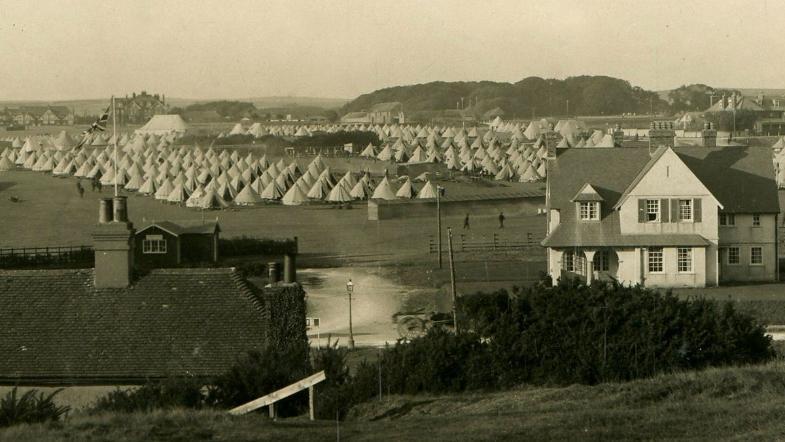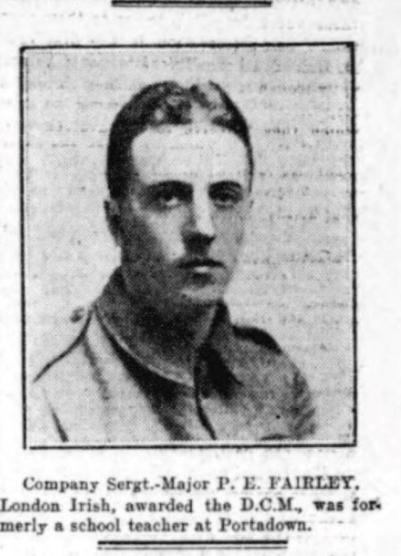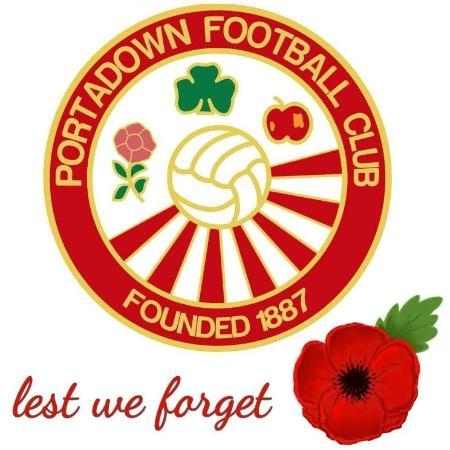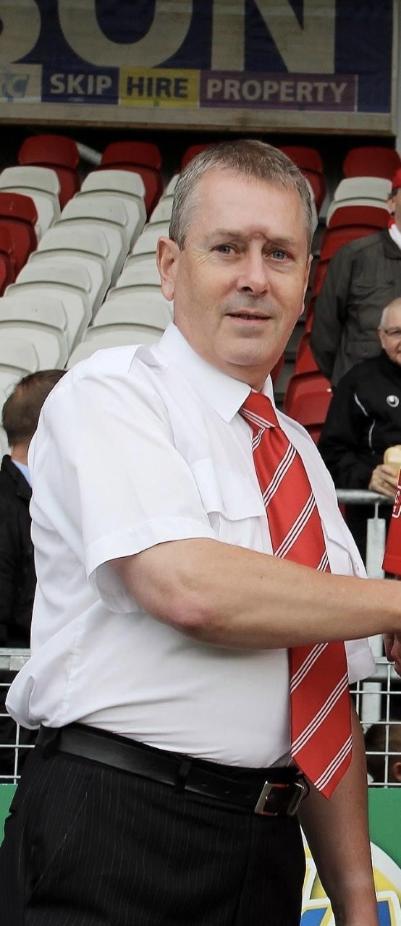Portadown FC - A Call to Arms
08/12/2021 - 4.31
Trevor Clydesdale
Each year during November, the thoughts of the nation turn to remembrance and at Portadown FC we recall those associated with the club that paid the ultimate sacrifice.
In the summer of 1914, war was declared, and the young men of Britain rallied to the cause. It was a war they were told would be over by Christmas, but no-one had any idea of the hell that lay ahead for them. Football continued as those at home waited for the war to end and the lads to come back home. The reality though was a different matter, and as you look at the War Memorial you will see the names of several Portadown FC footballers who gave their lives for freedom.
The previous season, 1913/14, The Reds had been playing in the Irish Junior League, finishing in eighth place.
When war was declared against Germany on 4 August 1914, the men of Portadown FC and their supporters, were quick to answer Kitchener’s call. Amongst the first of The Reds players to join up were men such as Hughes, Hayes, Moore, Liggett, Lamb, Vennard, Reavey and Jenkinson. They were soon followed by Lindsay, Cochrane, Curry, Johnston, Holmes and Henry.. Further afield many Portadown men that had gone to pastures new in Canada would join up with ‘The Canadians’ including former Ports player George McFadden. Putting a team on the field was becoming difficult, with the Portadown News on 19 September 1914, advising, “Everyone knows that it is impossible to recruit a first class team now against such a competitor as Lord Kitchener, so if we decide to go on we must hope for the best, and prepare for casualties. The present week will witness another host of brave lads rallying to the King’s colours, and their goal will, we hope be Berlin.” On September 26, 1914, the Portadown News was reporting that, “Tom Liggett was in town a few days ago on furlough, when he joined in double harness. Congratulations to Tommy, no matter where you may be now”, a familiar reference to the fact that he had got married. In the same edition the departure for camp was notified, On Monday intense enthusiasm prevailed in Portadown when the local volunteers left for Clandeboye. In the ranks of the brave were several Portadown players, amongst them being Lindsay, Milligan and Johnston. May they all return home after victory has been gained, is the wish of the writer.”
The Portadown News on December 5, 1914, reported that “Joe Vennard and a host of others passed through Portadown on Saturday dressed in Khaki, for duty somewhere in Europe.
The 9th (County Armagh) Battalion, The Royal Irish Fusiliers was raised in Belfast in September 1914, from the Armagh, Monaghan and Cavan Volunteers units of the Ulster Volunteer Force. The Battalion was attached to 108th Brigade, 36th (Ulster) Division. The men trained at Duffer in and Ava Estate at Clandeboye, County Down, and in July 1915, the Division moved to Seaford in Sussex and then to France in early October 1915.
The impact on Portadown FC was immediate with the club losing the first seven games of the 1914-15 Junior League season. The Portadown News likened the team to the Austrian Army, where disaster followed disaster. During the 1914-15 season, Portadown were able to call upon the services of a number of players that were in military training at various locations including Seaford, Victoria Barracks and Palace Barracks. The Portadown News on 17 October 1914 reported, “All is going well with ex-Portadown footballers at Clandeboye Camp. A team of recruits have had their photograph taken, and in the group appears Jack Cochrane, Albert Lindsay and Eddie Barr.” In the same edition we learnt that, “Davy Mercer’s sojourn in Portadown was of short duration. He has now answered the call of his country to operate in another field.” With their assistance the team reached the IFA Intermediate Cup Final, losing out to UCD after a replay. They also fell at the final hurdle in the Mid-Ulster Cup losing 3-1 to Lurgan Celtic.
A first league victory was recorded on 14 November 1914, when goals from Henry (2) and Lyttle secured a 3-0 win away Dunmurry. The Ports team was strengthened when the boys in khaki whole heartedly answered the call to don the red shirt. Amongst those back from camp to line out against Dunmurry were Cochrane, Henry, Lindsay, Johnston and Mercer. In the early days of the war players were given leave from camp at Clandeboye and from the Victoria Barracks in Dublin, to turn out for the Ports. Indeed, the 9th Battalion RIF had a very good football team, helped in no small measure by Portadown players such as Davy Mercer, Jack Cochrane, Albert Lindsay, Robert Milligan and James Holmes. The Reds victory against the villagers of Dunmurry was only a temporary success, and after several more defeats the News proclaimed, “If the British Army fought with the same skill and pluck as Portadown does on the football field, we would be sad people today.” With a dry wit they preferred this peril of wisdom, “To gain a victory now it would take them to be equipped with rifles, bayonets and field guns……Then perhaps they could shoot”.
A new Intermediate League was formed in Ireland for the 1915-16 season and Portadown were selected as one of the inaugural members of the set-up. Such were the numbers of players and supporters of the club on active service however ‘The Reds’ had to withdraw from the new competition before it began. It was a severe blow to club, and it took them the best part of a decade to reform and regroup.
By the start of the 1915-16 season however, Portadown FC were finding it virtually impossible to field a team. The Portadown New of the 4 September 1915 reported: “Although Portadown has been drawn against Roseville in the Intermediate League, it is not likely that there will be any club of importance in Portadown this season. So far as the Reds are concerned, the effect of the war has made it impossible for them to face the music. No less than 20 of the playing members are serving with the colours, ten of whom are at the front, and the other ten at Seaford. This is, indeed, a proud record for the club, and those who think there should be “business as usual” at Shamrock Park must know in their hearts that to form a club now would mean utter disaster. Without taking the question of finance into consideration, the sub-joined list of those in khaki show at a glance how the club has been hit:- A. Moore, J.Lamb, J.Hughes, J.Vennard, J.Reavey, W.Steenson, R.Currie, A.Hayes, T.Liggett and J.Jenkinson, all at the front, and not a few wounded. Stationed at Seaford:- A.Lindsay, E.Barr, S. Johnson, H.Jones, R.Milligan, D.Mercer, E. Larmour, J.Cochrane, W. Henry and J.Holmes.”

Seaford Camp. Source: Author's Collection
By that time, five Ports players had already been wounded including Joshua Jenkinson who had been serving in the Dardanelles and was wounded in the fight for ‘Chocolate Hill’. In the same theatre of war, Richard Currie had also been wounded.
The following year, 1916, the 36th Ulster Division went ‘over the top’ at the Somme and the men of Portadown FC in the 9th Royal Irish Fusiliers, ‘Blackers Boys’, were to the fore. The Battalion suffered great losses with 240 killed on the 1 July, including Corporal William Robb. A number of Reds player were wounded including Sergeant Eddie Barr and Private Robert Milligan.
With the Home Rule crisis rumbling on, the Portadown Times in May 1916, was reporting on the possibility of the local Volunteers forming a team to compete in the town. “The local force has many footballers in their ranks, who are now engaged in more strenuous work than dribbling a ball along a green field.” Poignantly in the same report the ‘News’ commented that, “It is possible that Jimmy Lamb, who is residing in Glasgow, will shortly leave that place for Australia.” He would ultimately return home and join the ranks of what was described in sporting circles as ‘The Great International Match’.
The men from Shamrock Park fought bravely throughout the Great War and several were decorated for their gallantry. Quartermaster-Sergeant Edward Larmour was awarded the Meritorious Service medal and Sergeant-Major James Hughes, wounded in the face October 1916, was awarded the Military Medal for his actions in April/May 1917, during the fighting at the Chemical Works, Roeux. He was awarded the Distinguished Conduct Medal for gallantry under fire 23 March 1918, during the retreat from St Quentin. James Hughes paid the ultimate price for his actions on that day.

Sergeant-Major James Hughes: Source Author's Collection
The Portadown News of 14 September 1918 reported:
“The King has been graciously pleased to approve of the award of Distinguished Conduct Medal to the undermentioned:
4517 Sergeant J. Hughes, M.M., Royal Irish Fusiliers, (Portadown). For conspicuous gallantry and devotion to duty. He went forward with a Lewis gun and knocked out an enemy machine gun, which was firing on our right flank. When his team were disabled, although wounded himself, he kept the gun in action until reinforcements came up.”
On the 1 July 1916, the Portadown News reported that “…Sergeant-Major Fairley, who has won the DCM, was well known in football circles, having assisted Portadown and the Commercials on several occasions.”

Lieutenant Philip Ernest Fairley: Source: Author's Collection
Philip Ernest Fairley was a schoolteacher at Annaghmore National School and Water Street School before moving to London. He gained a number of rapid promotions achieving the rank of Lieutenant.
The citation for is award read, “For conspicuous gallantry under heavy fire during the repair of trenches which had been blown in”. He was wounded in action in 1917 and eventually succumbed to his injuries in February 1919. His association with local football clubs in Portadown was mainly in an administrative roll.
This was to be ‘The war to end all wars’ but we know only too well that was not to be.
During World War Two, members of all three services with a connection to Portadown FC lost their lives. Joe Rooney, a defender with Wolverhampton Wanderers was on the Portadown retained list while stationed in Northern Ireland during World War Two. He was killed in the Belfast blitz in 1941. Harry Kane who had been a trainer and player with the Reds was killed while serving with the Royal Navy Reserve. Robert Montgomery, who had been transferred to Leeds United before the war was killed while serving with Bomber Command.
As we pause to remember all those who give their lives for our freedom, take a moment to remember all those young men that had pulled on the Red shirt for Portadown FC.

Biography
Trevor is currently the Media Officer and Club Historian for Portadown FC. He has been following Portadown FC in the Irish League for over 50 years. In 2004, he was appointed joint programme editor for the Portadown FC Matchday programme, “Ports in Focus”. His main passion in this role was to research and present the history of the club. It was always recorded that the club was founded in 1924, a date which featured on the club badge. From his research however, Trevor unearthed information which confirmed that the club was actually founded in 1887 and featured as a junior club until the Great War. The club badge now bears the date 1887.
Over the past number of years, Trevor has turned his attention to researching players associated with the club that have paid the ultimate sacrifice in service of the nation. In particular, he has presented to the club details of a number of players that were killed in action during the Great War. A particularly pleasing outcome is that the club now holds an annual remembrance service in November to commemorate those fallen heroes.
Trevor’s Second World War research produced information on Joe Rooney, who was signed from Wolverhampton Wanderers while on military service in Northern Ireland. It turned out that Wolves had actually recorded information on the wrong Joe Rooney in their records and as a result the club were able to put the record straight.
Trevor is always on the lookout for new information and in particular, photos of those players that laid down their lives. If anyone can assist with photos or contacts for information, please forward the details to Trevor at t.clydesdale@btinternet.com



/prod01/wlvacuk/media/departments/digital-content-and-communications/images-2024/240328-Varsity-Line-Up-Resized.jpg)
/prod01/wlvacuk/media/departments/digital-content-and-communications/images-18-19/220325-Engineers_teach_thumbail.jpg)
/prod01/wlvacuk/media/departments/digital-content-and-communications/images-18-19/240509-Find-the-Captain-Pencil-Drawing-Resized.jpg)
/prod01/wlvacuk/media/departments/digital-content-and-communications/images-2024/240320-Uzbekistan-Resized.jpg)
/prod01/wlvacuk/media/departments/digital-content-and-communications/images-2024/240229-The-Link-Resized.jpg)